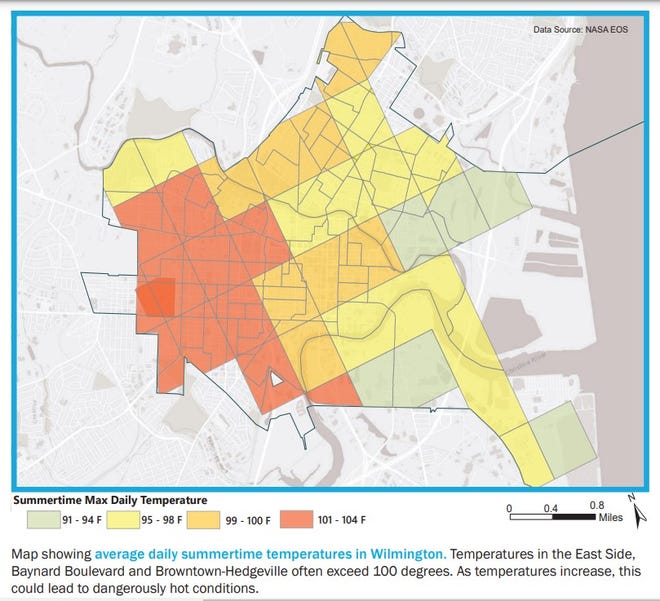The effects of Earth’s changing climate are being felt now.
Temperatures are increasing. Seas are warming; oceans rising. And scientists have said both heat and sea-level rise are helping make some natural disasters more extreme.
Look two or three decades ahead, and the picture worsens.
Climate change is ramping up long-term risk just about everywhere on the globe. But even in the United States alone, it will not be felt equally. Some areas may experience more heat, more floods, more extreme weather, more wildfires or all of the above.
Some locations might surprise you; some may not.
Delaware lies among them.
USA TODAY looked at data from First Street and Moody’s Analytics — two organizations examining climate risk — to see what areas of the country are most vulnerable over the next 30 years. Consequences vary widely over time, reports USA TODAY’s Dinah Voyles Pulver this week, but a growing body of evidence has helped highlight general trends.
NATION:Climate change is bad for everyone. But this is where it’s expected to be worst in the US.
Who’s at risk of climate change impact?
Climate change has been pumping up the rain in some tropical storms, while the heavier, wetter systems are also likely moving more slowly down their destruction paths. This research is ongoing, USA TODAY reports.
In a Moody’s Analytics study on climate risks in the United States, published earlier this year, author Adam Kamins ranked states on acute physical risk. This is based on weather-related events, like hurricanes, as well as disasters like flooding and wildfires.
Delaware came in at No. 5.
That makes the small state the fifth most at risk of the threats of physical disaster fueled by climate change. When considering the economic costs of climate change, damage to physical assets could be “the most intuitive starting point,” Kamins writes.
More extreme weather takes a greater toll when population and development increase in these areas. Long term, scientists say areas could start to experience “out-migration” to areas less exposed to climate risks.
Acute physical risk rankings:
- Florida
- Louisiana
- South Carolina
- North Carolina
- Delaware
- Rhode Island
- New Jersey
- Virginia
- Massachusetts
- Connecticut
Northeast:They struggled during Ida. Now one Wilmington community is finding a better way to respond
New Jersey also had several counties among the top of First Street’s lists for potential increases in average annual wind losses, extreme fire risk and properties at risk of flooding. New Jersey already suffered three hurricanes or their remnants in 2021-22.
Experts from Delaware’s Department of Natural Resources and Environmental Control said many risks are shared with nearby states in the region.
What about risk that doesn’t grab headlines?

Moody’s Analytics also took a look at places with more gradually increasing risk — think sea level creeping up, nights getting warmer, average temperatures swelling.
Some cities are particularly exposed to change over time, compared with single events.
Wilmington fell in at No. 8 in this chronic physical risk ranking.
For Delaware’s largest city, vulnerability to increasing heat, sea-level rise and water stress compounded in Kamins’ analysis. In a 2021 Climate Action Plan, Delaware similarly identified increased average temperatures, hotter and longer summers, rising sea levels and increased precipitation as key consequences of climate change in the state.
Delaware’s average overall temperature has already increased by 3 degrees Fahrenheit since about 1900, Susan Love, DNREC’s Climate and Sustainability section administrator, told USA TODAY Network.
This combines with rising seas. DNREC’s Coastal Program has projected 1.7 to 5 feet of sea-level rise by the year 2100, according to a 2022 report. In addition to Delaware’s low-lying topography, the state is also experiencing land subsidence, or sinking.
From Earth Day:Scientists told us what 2050 could be like. Their answers might surprise you.
EPA:People of color face disproportionate harm from climate change
Chronic physical risk appears widespread:
- San Francisco
- Cape Coral, Florida
- New York City
- Long Island, New York
- Oakland, California
- Phoenix
- Tucson, Arizona
- Wilmington, Delaware
- West Palm Beach, Florida
- North Port, Florida
Warming, warming, warming

Wilmington already sees an average of seven more days a year over 90 degrees than it did 50 years ago.
The state is tied with Arizona as the fourth-fastest warming state based on temperature trends since 1970. Average temperatures are projected to increase 2.5 to 4.5 degrees by 2050, from 2012 averages. That could rise up to 8 degrees by 2100, according to DNREC, in the worst emissions scenario.
Love said the climate in Delaware, over time, “is going to start tracking more like the climate in Georgia.”
Historically just one day above 100 degrees would be rare in Delaware, coming about once a year, if that. But by 2050, the state’s plan warns of two to eight each year, alongside projections of up to five nights with temperatures above 80.
What’s an urban heat island?Not all Wilmington neighborhoods experience the same summer heat. Here’s why.
Breaking down the science:Is climate change fueling massive hurricanes in the Atlantic?
This puts human health — elevating risks of heat exhaustion, heat stroke, various respiratory issues and other diseases — natural resources, agriculture and even infrastructure at risk. Populations particularly at risk from high heat include children, older adults, people who work outside, people with underlying health conditions and people with limited access to cooling.
Higher temperatures also increase the evaporation of water from soil and can increase water demand, which could affect drinking water supplies, according to DNREC, particularly in New Castle County.
With much of this impact, the coming severity remains somewhat in human hands.
This more extreme future will likely demand physical adaptation, according to First Street’s national report on hazardous heat, as well as planning for emergency heat events, from checking on residents, to creating more cooling centers or ensuring people can reach them.
Scientists also say substantial action to hold warming below 3 degrees Fahrenheit could limit the worsening of extreme weather, though certain sea level increases would already be locked in from existing emissions.
Regardless, areas outlined in First Street and Moody’s Analytics reporting remain exposed.
Have a story to tell? Delaware Online/The News Journal is placing a special emphasis on reporting about heat impact this summer, as part of an ongoing Perilous Course project across USA TODAY Network Northeast examining the human-centered damage and risks driven by the climate crisis.
Contact this reporter at kepowers@gannett.com or (231) 622-2191, and follow her on Twitter @kpowers01.